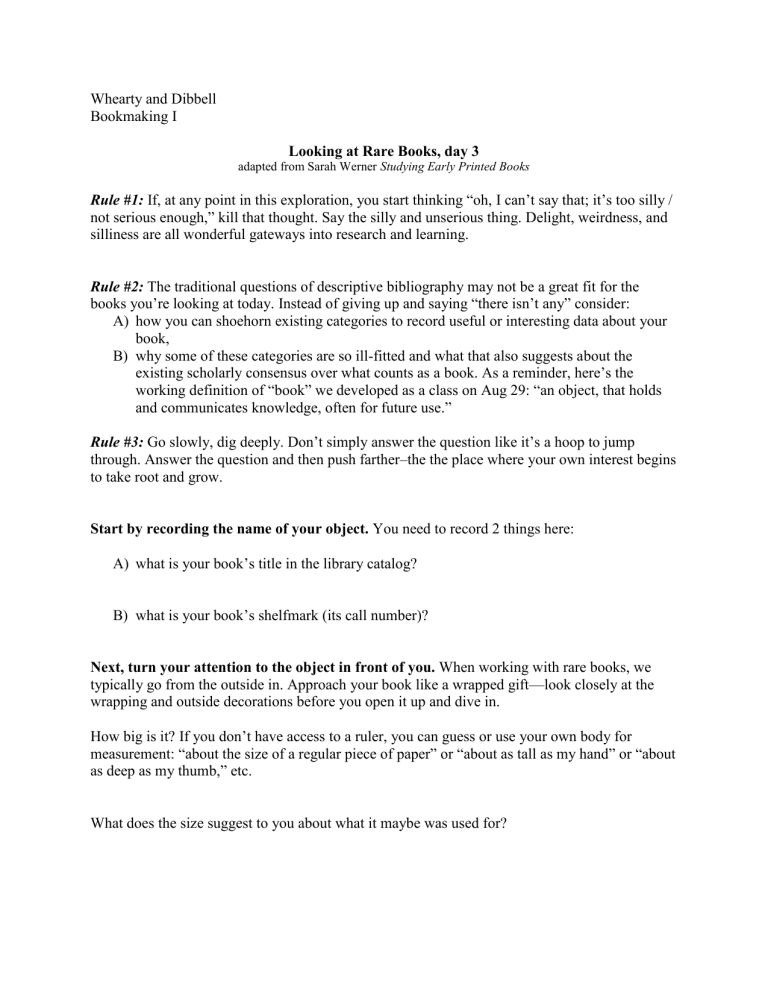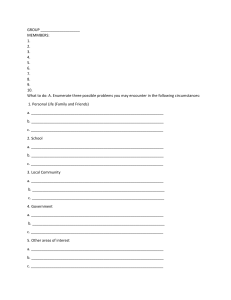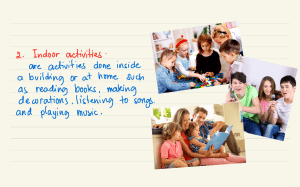
Whearty and Dibbell Bookmaking I Looking at Rare Books, day 3 adapted from Sarah Werner Studying Early Printed Books Rule #1: If, at any point in this exploration, you start thinking “oh, I can’t say that; it’s too silly / not serious enough,” kill that thought. Say the silly and unserious thing. Delight, weirdness, and silliness are all wonderful gateways into research and learning. Rule #2: The traditional questions of descriptive bibliography may not be a great fit for the books you’re looking at today. Instead of giving up and saying “there isn’t any” consider: A) how you can shoehorn existing categories to record useful or interesting data about your book, B) why some of these categories are so ill-fitted and what that also suggests about the existing scholarly consensus over what counts as a book. As a reminder, here’s the working definition of “book” we developed as a class on Aug 29: “an object, that holds and communicates knowledge, often for future use.” Rule #3: Go slowly, dig deeply. Don’t simply answer the question like it’s a hoop to jump through. Answer the question and then push farther–the the place where your own interest begins to take root and grow. Start by recording the name of your object. You need to record 2 things here: A) what is your book’s title in the library catalog? B) what is your book’s shelfmark (its call number)? Next, turn your attention to the object in front of you. When working with rare books, we typically go from the outside in. Approach your book like a wrapped gift—look closely at the wrapping and outside decorations before you open it up and dive in. How big is it? If you don’t have access to a ruler, you can guess or use your own body for measurement: “about the size of a regular piece of paper” or “about as tall as my hand” or “about as deep as my thumb,” etc. What does the size suggest to you about what it maybe was used for? What does the substrate look like? Be as detailed as you can be (which may involve being more detailed than you might initially wish): - what does it look like? - what does it feel like? - what does it smell like? - as you turn it, what does it sound like? - where do you encounter signs of the animal aspects of the parchment? - how is this writing support categorically different from the other writing supports you encounter in your daily life: paper, your phone, your computer, etc.? - how is it different from the other writing supports you have encountered already in this course? Are there ownership marks1? What do you see and what (if anything) do these suggest about your book’s provenance?2 As you explore: what do you notice? What leaps out at you?! What is the overall impression an opening3 makes? Are the pages densely full of words? Is there lots of blank space? Are there decorations? How many? How big? Describe (some of) them. 1 Ownership marks: things like bookplates, library call numbers or shelfmarks, booksellers descriptions, prices, exhibition labels, handwritten names, doodles, library stickers or stamps, etc. 2 Provenance: strictly speaking, a book or piece of art’s record of ownership. More broadly, this artifact’s long journey through human history, from when it was first made until your experience with it today. 3 Opening: any two pages facing each other; what you see when you open up a book. Are there any interesting signs of damage? Are some parts more worn than others? What delights you? What confuses and/or befuddles you? What do you want to learn more about, exactly? What does it make you think of—is it like any books, or art, or buildings, or videogames, or tattoos, etc.—that you’ve seen elsewhere? What about your book feels unique and/or new? How, when you push yourself to sit deeply with the animal origins of the writing support, does it that fact sit with you? Does it shift the meaning of your encounter with this object? Why or why not? Does it feel different than the texts you have encountered written on cellulose, metal, mud, and bone? Why or why not?



